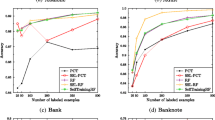Abstract
Previous chapters have discussed the use of decision forests in supervised problems as well as unsupervised ones. This chapter puts the two things together to achieve semi-supervised learning. We focus here on semi-supervised classification, but the approach can be extended to regression too. In semi-supervised classification we have available a small set of labeled training data points and a large set of unlabeled ones. This is a typical situation in many practical scenarios. For instance, in medical image analysis, getting hold of numerous anonymized patients scans is relatively easy and cheap. However, labeling them with ground truth annotations requires experts time and effort and thus it is very expensive. A key question then is whether we can exploit the existence of unlabeled data to improve classification. After a brief literature survey, we show how to adapt the abstract forest model of Chap. 3 to achieve efficient semi-supervised classification.
Access this chapter
Tax calculation will be finalised at checkout
Purchases are for personal use only
Similar content being viewed by others
Notes
- 1.
In this experiment the SVM and transductive SVM results were generated using the “SVM-light” Matlab toolbox in http://svmlight.joachims.org/. Parameters were chosen manually to try and produce the visually best results.
References
Budvytis I, Badrinarayanan V, Cipolla R (2011) Semi-supervised video segmentation using tree structured graphical models. In: Proc IEEE conf computer vision and pattern recognition (CVPR)
Burr A (2010) Active learning literature survey. Technical Report 2010-09-14, Univ Wisconsin Madison, Computer Sciences Technical Report
Chandna P, Deswal S, Pal M (2010) Semi-supervised learning based prediction of musculoskeletal disorder risk. J Ind Syst Eng
Chapelle O, Schölkopf B, Zien A (2006) Semi-supervised learning. MIT Press, Cambridge
Cohn DA, Ghahramani Z, Jordan MI (1996) Active learning with statistical models. J Artif Intell Res 4
Criminisi A, Sharp T, Blake A (2008) GeoS: geodesic image segmentation. In: Proc European conf on computer vision (ECCV). Springer, Berlin
Criminisi A, Shotton J, Konukoglu E (2011) Online tutorial on decision forests. http://research.microsoft.com/projects/decisionforests
Criminisi A, Shotton J, Konukoglu E (2012) Decision forests: a unified framework for classification, regression, density estimation, manifold learning and semi-supervised learning. Found Trends Comput Graph Vis 7(2–3)
Driessens K, Reutemann P, Pfahringer B, Leschi C (2010) Using weighted nearest neighbour to benefit from unlabelled data. In: Advances in knowledge discovery and data mining. 10th Pacific-Asia conference
Joachims T (1999) Making large-scale SVM learning practical. In: Schölkopf B, Burges C, Smola A (eds) Advances in kernel methods—support vector learning. MIT Press, Cambridge
Leistner C, Saffari A, Santner J, Bischoff H (2009) Semi-supervised random forests. In: Proc IEEE intl conf on computer vision (ICCV)
Rosenberg C, Hebert M, Schneiderman H (2005) Semi-supervised self-training of object detection models. In: 17-th IEEE workshop on applications of computer vision
Szummer M, Jaakkola T (2001) Partially labelled classification with Markov random walks. In: Advances in neural information processing systems (NIPS)
Vapnik V (2000) The nature of statistical learning theory. Springer, Berlin
Wang J (2007) On transductive support vector machines. In: Prediction and discovery. American Mathematical Society, Providence
Zhu X, Goldberg A (2009) Introduction to semi-supervised learning. Synthesis lectures on artificial intelligence and machine learning. Morgan and Claypool Publishers, San Rafael
Author information
Authors and Affiliations
Editor information
Editors and Affiliations
Rights and permissions
Copyright information
© 2013 Springer-Verlag London
About this chapter
Cite this chapter
Criminisi, A., Shotton, J. (2013). Semi-supervised Classification Forests. In: Criminisi, A., Shotton, J. (eds) Decision Forests for Computer Vision and Medical Image Analysis. Advances in Computer Vision and Pattern Recognition. Springer, London. https://doi.org/10.1007/978-1-4471-4929-3_8
Download citation
DOI: https://doi.org/10.1007/978-1-4471-4929-3_8
Publisher Name: Springer, London
Print ISBN: 978-1-4471-4928-6
Online ISBN: 978-1-4471-4929-3
eBook Packages: Computer ScienceComputer Science (R0)




